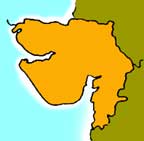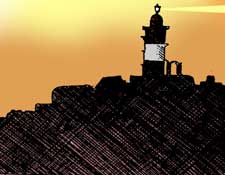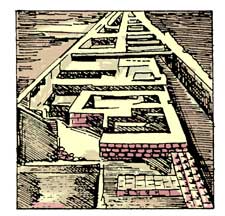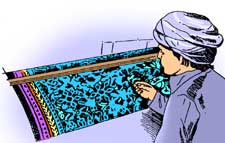
Dimdima
Online Children's Magazine from India

Dimdima
Online Children's Magazine from India

At the entrance of the Gulf of Khambat, a narrow, swampy channel connects mainland Gujarat to the picturesque little island of Diu, which is barely 40 sq.km. in area.The Portuguese occupied it in 1593. It became an integral part of India in 1961.
 The most imposing structure on the island is the Fort of Diu which was constructed by the Portuguese. The massive structure inside the fort now houses a lighthouse whose gas-flame glow can be seen from the mainland on clear nights.
The most imposing structure on the island is the Fort of Diu which was constructed by the Portuguese. The massive structure inside the fort now houses a lighthouse whose gas-flame glow can be seen from the mainland on clear nights.
The Alang ship-breaking yard, the largest one of its kind in the world today, lies 40 kilometres from Bhavnagar. Ships have expiry dates, after which, it is necessary to break them for safety reasons. At the Alang yard, established in 1983, ships from all over the world are brought for breaking. Because of the unusual movement of the tides and currents, ships can be brought right to the shore — something which is not possible in most shipping yards, where ships have to be moored at least 1000 metres from the shore.
The coastal town of Sanjan lies near the end of the coastline of Gujarat. A stone pillar, with the symbol of fire on top, marks the place where the Parsis landed in the 8th century A.D. Jadi Rana, the Maharaja of Sanjan,was at first reluctant to let them stay.
"My kingdom is like a cup of milk, full to the brim. How can I accommodate your people?" he asked Meherji, the chief of the Parsi refugees.
In reply, Meherji simply dissolved some sugar in a bowl of milk and handed it over to the Maharaja to indicate that his people would assimilate with the local people and work for the common good.
The Iranshah Atash Behram, the fire temple built by the Parsis at Udwada, north of Sanjan houses the fire which the Parsis brought with them from Iran.
North-east of Alang lies the tiny rocky island of Piram. The rocks in its south-east corner are embedded with fossils of elephants, rhinoceroses, hippopotamuses, horses, oxen, antelopes, crocodiles, fresh-water tortoises and gigantic fishes.
 One of the places of interest in the Gulf of Khambat is Lothal, where archaeologists discovered relics belonging to the Indus Valley Civilization. Lothal was a port in ancient times. In the fourth millennium B. C., it had developed overseas trade with the Mesopotamian cities. The remarkable feature of the port at Lothal was the water-locking system, which enabled ships to float even at low tide. Heavy floods resulted in the silting of the channel. Today Lothal lies several miles inland.
One of the places of interest in the Gulf of Khambat is Lothal, where archaeologists discovered relics belonging to the Indus Valley Civilization. Lothal was a port in ancient times. In the fourth millennium B. C., it had developed overseas trade with the Mesopotamian cities. The remarkable feature of the port at Lothal was the water-locking system, which enabled ships to float even at low tide. Heavy floods resulted in the silting of the channel. Today Lothal lies several miles inland.
 South-east of Lothal, lies the once famous sea-port of Cambay or Khambat, after which the gulf is named. The discovery of oil here has brought it back into the limelight. The oil in this region is spread over a vast area. Ankleshwar in Bharuch district is another place in this belt where oil has been found. The city of Khambat is also known for its small-scale industries of agate, a semi-precious stone, in great demand in Middle East and south-east Asia.
South-east of Lothal, lies the once famous sea-port of Cambay or Khambat, after which the gulf is named. The discovery of oil here has brought it back into the limelight. The oil in this region is spread over a vast area. Ankleshwar in Bharuch district is another place in this belt where oil has been found. The city of Khambat is also known for its small-scale industries of agate, a semi-precious stone, in great demand in Middle East and south-east Asia.
 Only a few ancient ports along the gulf are identifiable today. Bharuch called Bharu Kachha in the past, was the chief distributing centre of western India. Surat on the Tapi river is an important industrial and commercial centre, famous for its silks and brocades. It is the country's biggest diamond-cutting centre. The English, the Dutch and the French set up trading posts and factories here in the 17 century.
Only a few ancient ports along the gulf are identifiable today. Bharuch called Bharu Kachha in the past, was the chief distributing centre of western India. Surat on the Tapi river is an important industrial and commercial centre, famous for its silks and brocades. It is the country's biggest diamond-cutting centre. The English, the Dutch and the French set up trading posts and factories here in the 17 century.
Last updated on :10/29/2004
Dimdima is the Sanskrit word for ‘drumbeat’. In olden days, victory in battle was heralded by the beat of drums or any important news to be conveyed to the people used to be accompanied with drumbeats.
Bharatiya Vidya Bhavan
K. M Munshi Marg,
Chowpatty, Mumbai - 400 007
email : editor@dimdima.com
Bharatiya Vidya Bhavan
505, Sane Guruji Marg,
Tardeo, Mumbai - 400 034
email : promo@dimdima.com
Dimdima.com, the Children's Website of Bharatiya Vidya Bhavan launched in 2000 and came out with a Printed version of Dimdima Magazine in 2004. At present the Printed Version have more than 35,000 subscribers from India and Abroad.